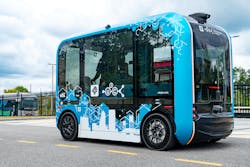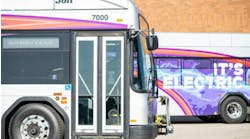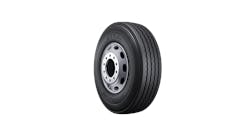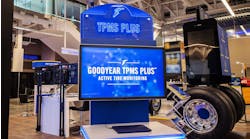Tires: Transit Industry Advancements Riding on Rubber
Emerging and evolving modes of transport require elements that are just as state-of-the-art. Tires, literally, carry the weight of service and are becoming specialized to handle autonomous vehicle operations and support the transit industry’s fleet electrification transition. Asset management solutions are also being enhanced to help fleet managers better maintain and optimize tire health and safety.
Airless Tires for AVs
Goodyear introduced a non-pneumatic tire (NPT) and wheel assembly to support autonomous vehicle transportation in a city setting at a July 13 event with the Jacksonville Transportation Authority (JTA). JTA will be the first in the industry to host the NPT on its autonomous vehicle fleet where Local Motors’ Olli 2.0 will be equipped with the airless tire as part of the Test & Learn Program as the authority continues to plan for its Ultimate Urban Circulator program.
At the event to introduce the tire, Goodyear Senior Program Manager, Non-Pneumatic Tires Michael Rachita notes alternative airless architectures are ideal to transform the way people move, especially when one considers autonomous transportation means driverless transportation.
“A fleet of robo-shuttles and delivery vehicles moving people and goods around cannot be slowed by operational issues that may arise from the need for tire care. We believe that airless tires have tremendous potential to meet certain performance requirements in these emerging sectors. A ‘touchless’ mobility solution enabling service up-time, better total cost of ownership and zero maintenance is at the forefront of these requirements as it pertains to AV shuttling,” said Rachita.
Goodyear and Local Motors tested an Olli shuttle supported by the NPT at Goodyear testing facilities and other locations during the past three years where the tire reached several performance targets with respect to load, speed and durability.
Local Motors President Vikrant Aggarwal explains a decrease in maintenance costs can translate to performance reliability for AVs such as Ollie.
“Goodyear's non-pneumatic tires are positioned to give maintenance teams less to worry about while giving passengers a quiet, consistent ride. Non-pneumatic tires may just be the industry standard in the coming years," said Aggarwal.
While in use at JTA, Goodyear and Local Motors will gather experiential data and look for viewpoints on ride comfort, noise and other variables.
“Performance metrics such as treadwear, tire noise, tire rolling resistance and ride comfort are being explored in the context of the unique operational and vehicle dynamics of AV/EV transport shuttles, which have wheel-mounted electric motors, autonomous starting and stopping and sensor-controlled steering feedback,” said Rachita.
Rolling with Electric Buses
In 2019, Michelin teamed up with Proterra to develop the X® InCity Energy Z tire for use on the bus manufacturer’s battery-electric buses. Launched in 2020, the X® InCity Energy Z joins Michelin’s X® InCity EVZ range to support the global transit industry’s move toward electric mobility solutions.
Michelin North America B2B Product Category Manager for Urban & Retread Thomas Stacey explains there are several considerations that go into developing a tire for use on electric buses including prioritizing low rolling resistance to maximize vehicle range.
“Special consideration also needs to be made for load-carrying capacity of the tire since electric transit buses can be heavier than conventional buses due to their battery weight. In addition to balancing the low rolling resistance needs, the tires must also deliver the mileage required by the fleet. The electric drive systems provide instant torque which effects a higher wear rate on the tire than standard [internal combustion engine] drivetrains,” said Stacey.
The Michelin X InCity Energy Z tire incorporates Michelin Advanced Technology™ tread compounds designed to provide low rolling resistance technology in the tire and the maximum carrying capacity per axle for the tire, which comes in a 315/80R22.5 L, is 18,740 lbs. Stacey says this is 2,640 lbs. more than a tire in size 305/70R22.5 L that would be found on most conventional transit buses.
“The X InCity Energy Z is well suited for urban environments with its Infini-Coil® belt technology which optimizes the shape of the contact patch for longer tread life and strengthens the crown against shocks and impacts,” said Stacey.
He noted the bead architecture features a special rubber permeated nylon wrap to extend integrity of bead components in urban transit operations, while sidewall wear indicators promote timely tire rotation for long casing life and enhanced retreadability. Additionally, regenerating full width grooves appear at end of life for improved wet traction. Full depth, interlocking sipes with zig-zag walls provide thousands of biting edges for traction and lug-like performance for even wear.
“As transport industries evolve toward electric vehicles, the usage conditions of tires will change along with the performance criteria that OEMs are seeking to prioritize. By working with innovators, such as Proterra, Michelin can learn firsthand what is needed to optimize the performance of the electric transit bus and the impact electrification has on tire performance. Michelin can then iterate accordingly to produce the best tire for the application,” said Stacey.
Connected Fleets
Revvo believes a connected fleet should include all elements – like tires – and the company’s platform helps fleet managers stay informed of their fleet’s tire health with information collected through brand agnostic tire-mounted sensors.
“Tire management should be stress-free, objective and trustworthy,” said Josh Schwartz, head of business development at Revvo. “Our solution combines best in market sensors, AI and machine learning models and tire data research to create a unique tire data platform. This platform helps operators, owners and drivers know the status and predicted remaining life of each tire.”
Schwartz explains Revvo’s reusable sensors are compatible with any type and size of tire, survive the retread process and provide tangible ROI for transit fleets.
“A tire’s wear and tear happens on the road, not in the shop. Monitoring in real-time enables transit fleet managers to take action immediately and avoid lengthy, and costly, downtime,” said Schwartz. “Real-time oversight of tire health leads to optimized maintenance intervals, fewer tire-related work orders and less technician time spent on tire-related maintenance. Real-time tire data allows fleet managers and drivers to take appropriate actions to prevent costly damage to the equipment and avoid dangerous situations for themselves and passengers.”
Schwartz notes Revvo’s AI automated monitoring eliminates extensive tracking and manual inspection, while optimizing fleet availability and ensuring fleet operations run as reliably, cost-efficiently and safely as possible.
“Transit fleets, buses specifically, tend to run big and expensive tires that seldom age-out before needing repair or replacement. Additionally, transit operations rely on multiple touch points from maintenance and servicing standpoints which, more often than not, depends on manual data input,” said Schwartz. “Remote access to real-time tire health allows for a higher level of accuracy at each touchpoint and a proactive and predictive style of tire management versus a reactive approach to downtime and/or roadside emergency events. Healthy tires are safe tires that last longer and cost less to maintain. There is nothing more valuable from a transit perspective than providing a positive passenger experience, keeping uptime consistently high and making sure drivers are operating safe equipment.”
Schwartz says Revvo is designed to be a frictionless experience from its customized preferences to its integration with other systems of record to avoid being one more dashboard to manage.
Monitoring Treads
Tyrata, Inc., a tire sensor and data management company, has developed its IntelliTread® Drive-Over System (DOS), which automates tire wear monitoring. The Tyrata IntelliTread® DOS collects tire tread depth every time a vehicle passes over the unit, which resembles a speed bump. The collected data is sent to a Tyratai.io cloud for analytics and displayed on a customer portal in real time where fleet managers can access and manage every tire in the fleet.
Luka Lojk, vice president of Sales and Marketing explains the system provides daily tire readings and historical trendlines, which gives fleet managers an overview of their fleet and enables optimized tire maintenance.
“DOS is easy to install, it is fully automated and requires no maintenance,” said Lojk. “Customer payment is based on a per tire per month subscription basis with no direct hardware or software cost.”
The system and data dashboard are customizable and Lojk notes Tyrata’s engineers can refine the company’s hardware to meet fleet specifications, while its software allows for custom tread wear settings for front and rear axles depending on customer goals.
The system has been studied at the Durham City Transit Company (GoDurham) in North Carolina, which manages a fleet of 60 buses. The study shows GoDurham saw a 12 percent tire and tire maintenance savings with the system. The transit company was able to eliminate manual tire measurements entirely and tire tread usage increased from 9.9 mm to 11.2 mm. GoDurham also reduced tire requirements by 100 tires per year, while maintaining fleet safety goals.
Lojk notes GoDurham was able to save roughly $1,000 per vehicle annually in tire-related cost.
“In addition to cost reduction, using tires longer also significantly reduces environmental impact through better fuel efficiency and reduced waste,” said Lojk.
While better analytics are appreciated and a goal of transit agencies, Lojk recognizes the main priority of transporting people is safety.
“Our experience with transit fleet managers is that they are especially vigilant regarding tire safety. Tyrata’s Drive-Over System enhances safety by providing much more frequent monitoring of every single tire in the fleet—daily in most cases. This allows the fleet manager to have complete oversight of all tires in their fleet every single day,” he said.

Mischa Wanek-Libman | Group Editorial Director
Mischa Wanek-Libman is director of communications with Transdev North America. She has more than 20 years of experience working in the transportation industry covering construction projects, engineering challenges, transit and rail operations and best practices.
Wanek-Libman has held top editorial positions at freight rail and public transportation business-to-business publications including as editor-in-chief and editorial director of Mass Transit from 2018-2024. She has been recognized for editorial excellence through her individual work, as well as for collaborative content.
She is an active member of the American Public Transportation Association's Marketing and Communications Committee and served 14 years as a Board Observer on the National Railroad Construction and Maintenance Association (NRC) Board of Directors.
She is a graduate of Drake University in Des Moines, Iowa, where she earned a Bachelor of Arts degree in Journalism and Mass Communication.



